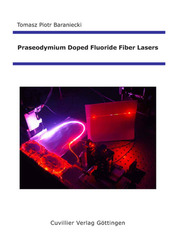| Departments | |
|---|---|
| Book Series (96) |
1378
|
| Nachhaltigkeit |
3
|
| Gesundheitswesen |
1
|
| Humanities |
2363
|
| Natural Sciences |
5406
|
| Engineering |
1791
|
| Engineering | 292 |
| Mechanical and process engineering | 861 |
| Electrical engineering | 686 |
| Mining and metallurgy | 30 |
| Architecture and civil engineering | 75 |
| Common |
97
|
|
Leitlinien Unfallchirurgie
5. Auflage bestellen |
|
Advanced Search
Praseodymium Doped Fluoride Fiber Lasers (English shop)
Tomasz Baraniecki (Author)Preview
Table of Contents, Datei (50 KB)
Extract, Datei (110 KB)
The goal of this work was to develop and investigate fiber lasers emitting in the visible spectral range. We concentrated on the improvement of lasers based on Pr3+/Yb3+-doped fiber. Blue, green, orange and red fiber lasers in different configurations were presented. We started with spectroscopic measurements in which Pr3+-doped ZBLAN and IBZP glass samples were investigated. Comparing the position of absorption peaks in both kinds of glasses, no significant differences were noticeable. However, the emission properties of Pr3+-doped fluoride glasses are dependent on the glass composition. The knowledge gained from spectroscopic measurements was useful to construct fiber lasers based on the Fabry-Perot configuration. This setup allowed us to obtain lasers emitting at 490 nm, 520 nm, and 635 nm. The greatest efficiency was found for a red laser with 20 mW of output power at a pump power of 500 mW. At the same pump power, the green and blue lasers had an output power of 9.3 mW and 4.8 mW, respectively. During this work, optimization of the laser parameters of the red laser was performed. We found that the optimum pump wavelength is approximately 840 nm, and pump wavelength changes of ± 10 nm cause only a small intensity deviation. The influence of mirror reflectivity and the fiber length was also investigated. Another focus of the measurements was the laser output stability. The red laser exhibited a very low noise level, but the output power from the blue laser was very unstable with strong self-pulsing behavior. For the red and green laser, we applied a noise controlling opto-electronic feedback loop, and we observed some reduction in the noise level. We also tested the long-term stability of our lasers over a period of one hour, and no significant decrease of the output power was observed. There are a number of disadvantages of the Fabry-Perot setup; therefore, we examined alternative approaches for all-fiber laser configurations. We constructed a red ring laser in which bulk mirrors are not required. This setup used directional couplers; therefore, some part of this work was dedicated to the manufacturing of these components. Another important component of the ring laser was glue splice which enabled us to connect silica and fluoride fibers. The optimum performance of the red ring laser was measured with an output coupling of 52 %, and we obtained 8 mW output power at 500 mW pump power. Another way to construct an all-fiber laser setup is fiber loop mirror. A laser with these components was also investigated. Because of the broad fluorescence width of the Pr3+ ions, fiber lasers operate in many longitudinal modes. Fiber Bragg gratings have a very narrow reflection bandwidth, and they have been used for narrowing the linewidth of the fiber laser. When a fiber grating was applied, we observed only one longitudinal mode, and the full-width at half-maximum of this laser was only 0.2 nm.
| ISBN-13 (Printausgabe) | 3865379575 |
| ISBN-13 (Hard Copy) | 9783865379573 |
| ISBN-13 (eBook) | 9783736919570 |
| Language | German |
| Page Number | 154 |
| Edition | 1 |
| Volume | 0 |
| Publication Place | Göttingen |
| Place of Dissertation | Braunschweig |
| Publication Date | 2006-07-17 |
| General Categorization | Dissertation |
| Departments |
Electrical engineering
|








